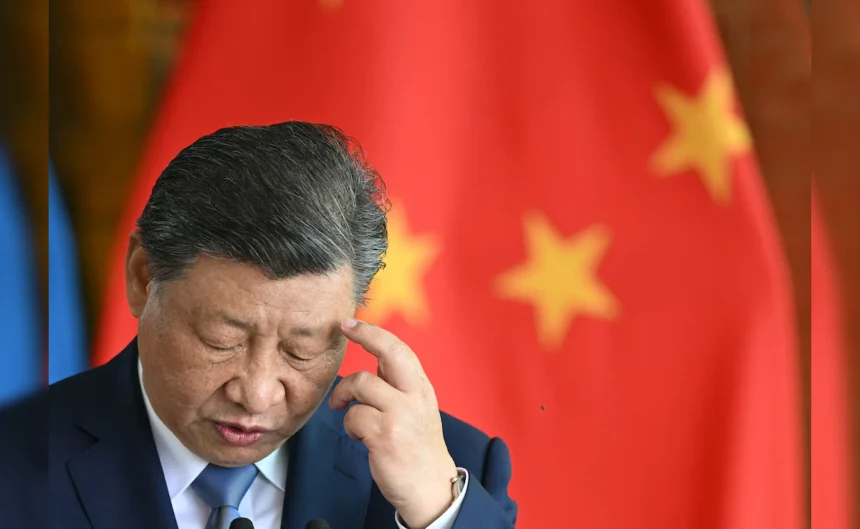BEIJING – Factories, once filled with workers and constant production, now sit quiet as manufacturing giants are shifting operations from China to India, Vietnam, and Thailand, changing global trade routes.
New U.S. tariffs on Chinese imports, now at 145%, have deepened the trade conflict and forced companies to move. This trend threatens millions of jobs in China, while India and Southeast Asia attract both investment and employment. Economic pressure and political tension are driving changes in the world’s supply chains.
In April 2025, President Donald Trump raised tariffs on Chinese goods to 145%. In response, China imposed 125% duties on U.S. products. These actions, called “Liberation Day” tariffs, have disrupted trade between the two countries.
In the weeks before tariffs took effect, Chinese exports jumped 12% as companies rushed to ship goods. Since then, China’s industrial index dropped to 49.0 in April, the lowest since late 2023. Factories have slowed, and unemployment is rising.
The tariffs were intended to restart U.S. factories and bring jobs home. Trump claims China has long taken advantage of American trade. However, the ripple effect is wide. Companies now face steep costs, and consumers are paying more.
The Economic Policy Uncertainty Index is at its highest since the pandemic, showing growing instability. Some economists warn that if tariffs stay in place, a global recession may follow, hitting China hardest.
Companies Seek New Production Bases
Tariffs have made Chinese factories less cost-effective for foreign businesses. Many are moving to countries where wages are lower, like India, Vietnam, and Thailand. India’s average income is $2,000 per person, Vietnam’s is $3,000, while China’s stands at $14,000.
This difference, plus U.S. incentives, makes shifting production attractive. Apple, for example, will buy 19 billion chips from the U.S. and grow iPhone production in India, cutting its reliance on China.
Vietnam has a $123.5 billion trade surplus with the U.S. Even with a 46% U.S. tariff, Vietnam remains a top choice. Vietnamese officials are negotiating with the U.S. to reduce tariffs, hoping their country’s role as a key shipping point for Chinese goods will help.
Thailand is also gaining ground due to its steady infrastructure and competitive costs. Some firms, though, cannot afford the move. Relocation costs and tariffs on Southeast Asian goods, such as the 46% on Vietnamese exports, force some to remain in China with unsold stock.
Social media posts show the trend. One user on X noted, “US clients are turning to Vietnam & India. Some factories can’t pay suppliers, & some risk bankruptcy.” Others warn that lower tariffs for Vietnam and India could worsen China’s manufacturing losses and cost even more jobs. These views highlight the tough choices facing businesses and workers alike.
Mounting Job Losses in China
China’s economy was already struggling with a property slump and high youth unemployment. Now, the threat grows. Goldman Sachs estimates up to 16 million Chinese jobs could disappear if tariffs stay. Manufacturing, retail, and export jobs are at risk.
When China’s manufacturing index fell, it signalled a wider downturn. Factories in places like Nanjing and Jiangsu are cutting work hours, leaving many without wages. With job losses rising and prices falling, the crisis deepens.
China’s leaders are taking action. Manufactu
Efforts include more unemployment benefits, looser monetary policy, and increased government borrowing. Local authorities are trying to shift exports to the domestic market, but results are limited. Meeting the 5% growth target for 2025 now seems unlikely, with experts expecting the economy to shrink further.
Laid-off workers face an uncertain future. In coastal regions, job cuts continue. A shipyard worker from Nanjing told state media, “We’re building fewer ships. My hours are cut, and I’m worried.” Youth unemployment keeps rising, and new graduates struggle to find jobs.
Government programs to boost entrepreneurship and lending have not reversed the trend. The effects of the trade war are clear in the number of closed factories and growing unemployment.
Wider Economic Fallout
U.S. companies are also feeling the pressure. General Motors has pulled its 2025 profit forecast, blaming tariffs on imported vehicles and components. UPS is cutting 20,000 jobs to manage higher costs. In America, consumer confidence has reached a five-year low, and retailers warn that supply chains are under strain, leading to potential shortages.
U.S. farmers have also suffered. China recently cancelled orders for 12,000 tonnes of pork, the most since 2020, causing layoffs and big losses for producers. The Agriculture Transportation Coalition reported “massive” losses as Chinese buyers stopped purchasing U.S. goods. With 9,000 metric tonnes of pork already shipped to China, exporters now face expensive diversions or the risk of leaving goods at foreign ports.
This trade conflict puts pressure on the world economy. The International Monetary Fund warns of possible financial turmoil. Europe, which has a large trade deficit with China, faces higher costs if it limits ties with Beijing. Developing countries that depend on Chinese imports find themselves caught in the middle. Without joint efforts, global trade systems could break down.
China Responds to Pressure
Beijing has stood firm, accusing the U.S. of acting out of “extreme selfishness.” Foreign Minister Wang Yi called the tariffs an “unjustified trade war” and urged the U.S. to lift them. China has exempted some U.S. imports from its tariffs, hinting at room for talks. But government messages have been mixed. While China’s commerce ministry denies ongoing negotiations, Trump claims discussions are underway.
President Xi’s latest trip to Southeast Asia aimed to strengthen ties with Vietnam, Cambodia, and Malaysia. These nations are becoming key channels for Chinese goods heading to the U.S., bypassing tariffs. Still, China’s diplomacy has not eased concerns about a possible “second China shock”—a wave of cheap exports that could hurt industries in other countries.
Wu Xinbo, an adviser to China’s foreign ministry, argues that Trump underestimated China’s ability to endure. “The U.S. thought China would give in under tariff pressure,” said Wu. Instead, China is getting ready for a long conflict by boosting local industries and finding new export markets. The price is steep, with reduced output and fewer jobs.
What’s Next
The U.S. and China are locked in a tough dispute. Trump has suggested dropping tariffs to 50% or 65%, but demands concessions from China. Treasury Secretary Scott Bessent says the current tariff levels cannot last and supports new trade agreements. India is close to a deal with the U.S., which has lifted local stocks and investor optimism. Vietnam’s talks with the U.S. are also advancing.
China’s future path is uncertain. The government’s support may soften the blow, but deeper issues remain, such as too many factories, an ageing population, and uneven growth between regions. The trade conflict has exposed how much China relies on global demand. Without major changes, job losses may continue and spark more unrest.
The impact on the world economy is severe. As production leaves China for India, Vietnam, and Thailand, supply chains are shifting at a rapid pace. U.S. tariffs and the ongoing trade battle have sped up these changes, increasing costs and uncertainty for everyone. Higher prices, lost jobs, and weaker confidence are now the reality. The next moves by Beijing and Washington carry high stakes, with millions of workers watching closely.














